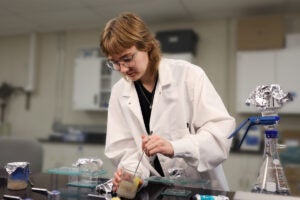The newest science building now being built on The University of Texas at Austin campus will be named in honor and memory of Dr. Norman Hackerman, chemist, professor and president emeritus.
The Norman Hackerman Building will house state-of-the-art classrooms and teaching labs for organic chemistry, research labs for faculty from the Department of Chemistry and Biochemistry, the Center for Learning and Memory and the Institute for Neuroscience and administrative offices for the School of Biological Sciences.

It replaces the original Experimental Sciences Building, which itself was a center of science research when it originally opened in 1952.”By naming this new building after Norm Hackerman we are forever honoring one of the most influential figures in the history of our university,” said William Powers Jr., president of The University of Texas at Austin. “Dr. Hackerman was a visionary leader, a superb scientist and a compelling advocate for higher education. This building will be an enduring symbol of his legacy.”Hackerman, who died in 2007 at the age of 95, had a long and highly esteemed professional life, a substantial portion of which was spent at The University of Texas at Austin. He joined the faculty in 1945 as assistant professor of chemistry and was an immediate agent for change. He had the first research grant at the university and was the first person to promote the university as an economic engine for the state.”Norm Hackerman was an amazing scientist, leader, educator and friend,” says Mary Ann Rankin, dean of the College of Natural Sciences, “and the new building embodies his forward-thinking ideals. It is the perfect honorarium for a great man.”

The Hackerman Building, designed by CO Architects, is to be a catalyst for collaboration among research groups and integration of various sciences. Laboratories and classrooms will support cutting-edge research and education, while plazas, porches and galleries will promote social activity and connectivity.
If funding becomes available, the building may also become one of the “greenest” buildings on campus, potentially featuring rooftop solar panels and a green roof. The solar array will be used to heat water and could be the largest solar hot water array in the state of Texas.
Hackerman was chairman of the Chemistry Department from 1952 to 1962. He was later appointed vice president and provost, vice chancellor of academic affairs at the University of Texas System, and finally, president of The University of Texas at Austin, where he served from 1967 to 1970. In 1970, he was appointed president of Rice University where, over 15 years, he is credited with transforming that institution.
Hackerman was inducted into the Texas Hall of Fame for Science, Mathematics, and Technology. He was a member of the National Academy of Sciences and the American Academy of Arts and Sciences. Among his many honors are the American Institute of Chemists’ Gold Medal, the Charles Lathrop Parsons Award of the American Chemical Society, the Vannevar Bush Award of the National Science Board and the National Medal of Science. Hackerman continued teaching freshman chemistry and directing a research group throughout his administrative career and beyond.



